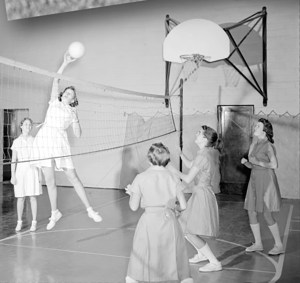Team dealers and road salespersons new to the industry might think that volleyball standards have always been aluminum or carbon fiber installed in floor sleeves.
This is far from the truth.
As in all sports, innovative manufacturers, coaches, independent inventors and players are always searching for the “better mousetrap,” or in this case, better volleyball net systems to meet changing needs.
The game of volleyball was first introduced in 1895 at the YMCA in Holyoke, Massachusetts, by William Morgan, four years after basketball was invented by James Naismith a couple miles down the road in Springfield. Both sports are truly American in their origin but have become popular worldwide.
The earliest net systems were likely homemade, with nets mounting to walls or other fabricated posts that attached to floors, to walls or both. As the sport of volleyball became more popular, both the rules and the equipment began to evolve. As recently as the early 1970s most indoor competition net systems included portable bases that attached to the floor and sometimes by cables to the wall depending on gym configuration.
Setup was time-consuming, floor attachment was undependable and wall cables created added safety concerns.
Beginning in the late 1970s, today’s floor socket designs with rigid — but heavy — steel standards became popular and most manufacturers offered two or three models with different features and price points.
In the mid-1980s, the first aluminum standards were introduced to the U.S. market from the Netherlands. While these 4-inch diameter standards were lighter weight and easier to set up, they lacked the rigidity needed for maximum net tension.
Bison was founded primarily as a basketball equipment manufacturer but first introduced their own design of steel volleyball net systems in 1991.
Recognizing the need for lightweight systems, but with improved rigidity, in late 1998 Mike Brown and Terry Schiltz of CenterLine Sports brought a superior telescopic aluminum system to the market. Based on its computer-designed aluminum extrusion shapes, this 3-inch diameter system not only fit in existing 3-inch sockets but was almost as rigid as steel and dramatically more rigid than 4-inch aluminum systems on the market.
Bison expanded its volleyball offerings by purchasing CenterLine Sports in 1999 and in December 2000 became the first official supplier of…
Click Here to Read the Full Original Article at Volleyballmag.com…

